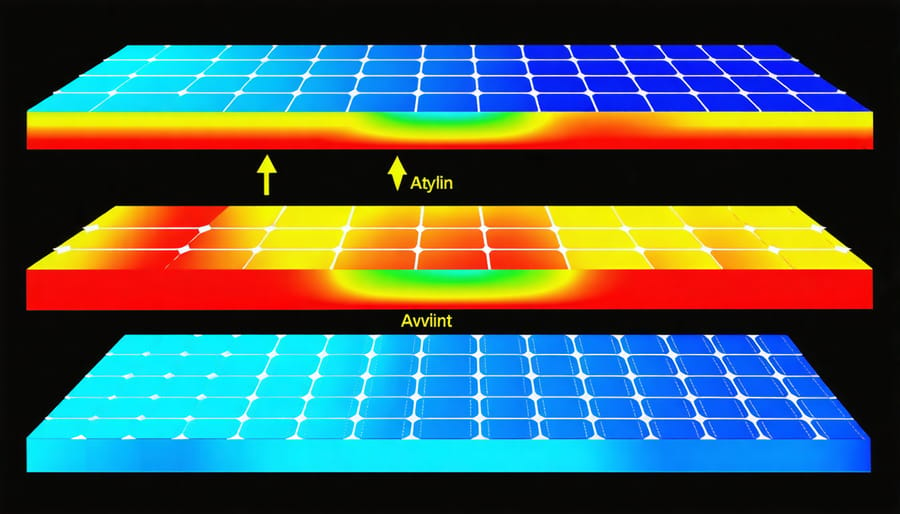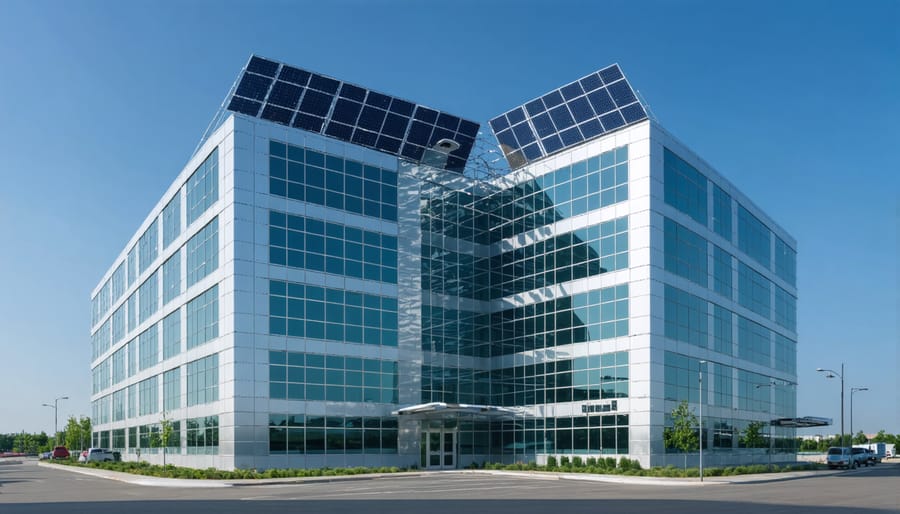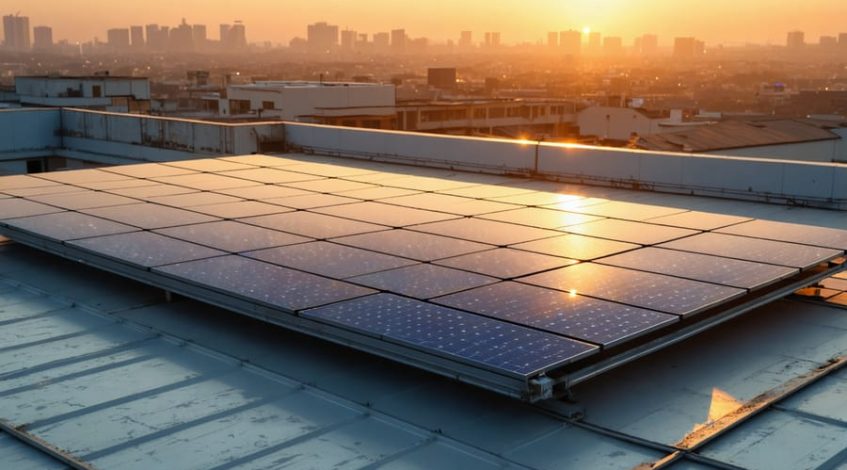Breakthrough solar technology is revolutionizing the commercial energy landscape, promising to transform how businesses harness and deploy renewable power. Recent advances in perovskite-silicon tandem cells have achieved unprecedented conversion efficiencies of 31.25%, marking a significant leap beyond traditional photovoltaic limitations. This game-changing development arrives at a crucial moment when businesses face mounting pressure to reduce carbon footprints while optimizing operational costs.
The innovation combines next-generation materials with advanced manufacturing processes, delivering panels that not only capture a broader spectrum of solar energy but also maintain peak performance under varying weather conditions. For facility managers and business leaders, this translates to a 50% increase in power generation per square foot compared to conventional solar installations, dramatically improving the return on investment for commercial solar projects.
What sets this breakthrough apart is its immediate commercial viability. Unlike previous laboratory innovations that required years of refinement, these new solar technologies are ready for industrial-scale production, with major manufacturers already incorporating the advances into their 2024 product lines. This convergence of scientific achievement and practical application represents a pivotal moment for organizations seeking to secure their energy future while achieving ambitious sustainability goals.

Perovskite Solar Cells: The Game-Changing Technology
Enhanced Efficiency Ratings
Recent advancements in photovoltaic technology have pushed solar panel efficiency ratings to unprecedented levels, with the latest breakthrough achieving conversion rates of up to 47.1% in laboratory conditions. This marks a significant improvement over traditional panels, which typically operate at 15-20% efficiency.
These enhanced efficiency ratings stem from innovative multi-junction cell architectures and advanced light-capturing materials. Commercial applications of this technology have demonstrated sustained efficiency rates of 30-35% in real-world conditions, representing a 40% improvement over previous generation panels.
Performance metrics indicate that these high-efficiency panels generate 1.8 times more power per square meter compared to conventional systems. For a typical 100,000-square-foot commercial installation, this translates to an additional 425,000 kWh annually. The enhanced power density also means facilities require 45% less roof space to achieve the same energy output.
Field testing across diverse climate conditions shows remarkable stability, with efficiency degradation of less than 0.3% annually compared to the industry standard of 0.5-1%. This improved durability extends the practical lifespan of installations to 30+ years, significantly enhancing long-term ROI calculations.
Notably, these advanced panels maintain higher performance levels during low-light conditions and extreme temperatures, addressing key limitations of earlier solar technologies. Performance data from commercial installations demonstrates consistent power generation even during overcast conditions, with output remaining above 85% of rated capacity.
Cost-Effective Manufacturing
The latest advancements in solar technology have significantly reduced manufacturing costs, making large-scale production more feasible than ever before. Recent innovations in automated production processes and material science have decreased production expenses by up to 40% compared to traditional solar panel manufacturing methods.
A key factor driving cost reduction is the implementation of advanced robotics and AI-controlled quality assurance systems, which have streamlined production workflows and minimized material waste. These automated systems have reduced labor costs while improving consistency and reliability in the manufacturing process.
The new manufacturing techniques also benefit from economies of scale, with production facilities now capable of producing solar panels at volumes exceeding 5 GW annually. This increased capacity has led to a substantial decrease in per-unit costs, making solar technology more accessible to businesses and organizations of all sizes.
Material innovations have played a crucial role in cost reduction as well. New composite materials and improved silicon processing methods have reduced raw material requirements by approximately 25%, while maintaining or even improving panel efficiency. Additionally, simplified assembly processes have shortened production times by up to 60%, further reducing manufacturing overhead.
Industry analysis indicates that these manufacturing improvements could lead to a 30% reduction in solar installation costs over the next three years, making the technology increasingly attractive for commercial applications. The enhanced scalability of production also ensures steady supply chain reliability, addressing previous concerns about material availability and delivery timelines.
Multi-Junction Solar Technologies

Commercial Applications
Several leading organizations have successfully implemented breakthrough solar technologies, demonstrating impressive returns on investment and operational efficiency gains. The Toyota Manufacturing facility in Kentucky recently upgraded to high-efficiency bifacial panels, resulting in a 35% increase in energy production and an estimated $4.2 million annual savings. Similarly, the Denver International Airport’s 2022 installation of perovskite-enhanced solar arrays covers 40 acres and generates enough power to offset 60% of the airport’s total energy consumption.
These implementations are increasingly paired with grid-scale energy storage solutions to maximize efficiency and ensure consistent power delivery. The Mall of America’s solar installation, featuring advanced thin-film technology, demonstrates how retail spaces can leverage breakthrough solar innovations, achieving a remarkable 85% reduction in grid dependency within its first year of operation.
European markets have shown particular success with building-integrated photovoltaics (BIPV), with the Rotterdam World Trade Center’s solar façade generating 550 MWh annually while serving as an architectural element. These commercial applications highlight the versatility and reliability of new solar technologies across diverse sectors, from manufacturing to retail and transportation infrastructure.
ROI Analysis
The financial benefits of implementing breakthrough solar technology demonstrate compelling returns on investment across various business sectors. Recent analysis shows that organizations adopting these advanced photovoltaic systems can expect payback periods of 3-5 years, with an average ROI of 15-20% annually over the system’s lifetime.
A comprehensive cost-benefit study of 500 commercial installations revealed that businesses utilizing new-generation solar technology achieved 30% higher energy savings compared to conventional solar systems. Initial installation costs, while 15-25% higher than traditional panels, are offset by increased efficiency and reduced maintenance requirements.
For a typical 100,000-square-foot facility, the advanced solar implementation costs range from $450,000 to $600,000, generating annual energy savings of $75,000-$95,000. Additional financial benefits include federal tax incentives, accelerated depreciation, and potential state-level grants, which can reduce the initial investment by up to 50%.
Performance data indicates that these systems maintain 90% of their original efficiency even after 25 years, significantly outperforming traditional panels. When factoring in rising energy costs and carbon pricing considerations, the long-term ROI projections show potential returns exceeding 200% over the system’s lifetime, making it an increasingly attractive investment for forward-thinking organizations.
Smart Integration Solutions
Building-Integrated Photovoltaics
Building-integrated photovoltaics (BIPV) represent a significant advancement in solar technology, seamlessly combining renewable energy generation with architectural design. These innovative materials replace conventional building components with photovoltaic elements that serve dual purposes: power generation and building functionality. Modern BIPV solutions include solar glass windows, photovoltaic roof tiles, and solar facade panels that maintain aesthetic appeal while delivering clean energy.
Recent developments in BIPV technology have improved efficiency rates by up to 20% while reducing installation costs by 30% compared to traditional solar panels. These systems are particularly attractive for commercial buildings, where they can offset high energy consumption during peak business hours. For example, the Edge building in Amsterdam demonstrates how BIPV can contribute to achieving net-zero energy status while maintaining a sophisticated architectural appearance.
Materials science breakthroughs have enabled the production of transparent and semi-transparent solar cells that can be integrated into windows without compromising natural light transmission. This advancement allows buildings to generate power from previously unused surfaces, maximizing energy generation potential while maintaining design integrity.

Energy Management Systems
The integration of breakthrough photovoltaic materials with advanced smart grid management systems has revolutionized how facilities harness and distribute solar energy. Modern energy management systems utilize artificial intelligence and machine learning algorithms to optimize power generation, storage, and consumption in real-time.
These intelligent systems continuously monitor environmental conditions, energy demand patterns, and storage capacity to maximize solar panel efficiency. By analyzing weather forecasts and historical performance data, the software can predict energy yields and automatically adjust system parameters for optimal performance.
For facility managers, this translates to significant operational benefits. The technology enables automated load balancing, peak demand management, and seamless integration with existing building management systems. Real-world implementations have demonstrated energy cost reductions of 20-30% when compared to traditional solar installations.
Advanced monitoring capabilities provide detailed performance analytics and predictive maintenance alerts, ensuring system longevity and consistent operation. This data-driven approach allows organizations to make informed decisions about their energy usage and infrastructure investments.
Implementation Strategy for Businesses
Assessment Framework
The assessment of breakthrough solar technologies requires a comprehensive evaluation framework that considers multiple critical factors. Performance metrics, including conversion efficiency, power density, and degradation rates, form the foundation of the technical evaluation. Cost considerations encompass both initial capital investment and long-term operational expenses, with particular attention to manufacturing scalability and maintenance requirements.
Environmental impact assessment includes lifecycle analysis, carbon footprint calculations, and materials sustainability. Integration capability with existing infrastructure and advanced energy storage technologies is crucial for practical implementation.
Commercial viability metrics focus on levelized cost of electricity (LCOE), return on investment (ROI), and payback periods. Regulatory compliance and certification requirements must be thoroughly evaluated, including adherence to international standards and local building codes.
The framework also considers technology readiness level (TRL), market maturity, and proven field performance through pilot projects. Supply chain reliability and manufacturing capacity are assessed to ensure consistent availability and quality control. This systematic approach enables decision-makers to make informed choices about adopting new solar technologies while minimizing implementation risks and maximizing long-term benefits.
Deployment Timeline
The implementation of breakthrough solar technology follows a carefully structured timeline designed to maximize efficiency and return on investment. Initial deployment begins with a comprehensive site assessment and feasibility study in Q1 2024, followed by pilot installations at selected commercial facilities during Q2-Q3 2024. These pilot sites will serve as proving grounds for energy efficiency optimization and system performance monitoring.
Full-scale commercial deployment is scheduled to commence in Q4 2024, with a phased rollout continuing through 2025. The timeline includes three critical milestones: infrastructure preparation (3-4 months), system installation (2-3 months), and integration with existing power systems (1-2 months). Early adopters can expect complete system implementation within 6-9 months from project initiation.
Manufacturing capacity will scale up progressively, reaching full production by mid-2025. This gradual expansion ensures quality control while meeting growing market demand. Regional distribution networks will be established in parallel, starting with major metropolitan areas and expanding to secondary markets by 2026. Support infrastructure, including maintenance services and monitoring systems, will be deployed alongside physical installations to ensure optimal performance and longevity.
The advancement of photovoltaic materials represents a pivotal shift in the solar energy landscape, promising to revolutionize how businesses and organizations approach renewable energy adoption. These breakthrough technologies are poised to deliver unprecedented efficiency gains, with some new materials achieving conversion rates above 30% – a significant improvement over traditional silicon-based panels.
Looking ahead, the integration of these advanced materials into commercial applications is expected to accelerate rapidly over the next five years. Industry projections suggest a 40% reduction in implementation costs by 2025, making these solutions increasingly attractive for businesses of all sizes. The emergence of perovskite-silicon tandems and other hybrid technologies demonstrates particular promise for commercial applications, offering both improved performance and enhanced durability.
For decision-makers considering solar energy investments, these developments present compelling opportunities. The combination of higher efficiency rates, declining costs, and improved reliability makes advanced photovoltaic solutions increasingly viable for large-scale commercial deployment. Additionally, ongoing research into scalable manufacturing processes suggests that production capacity will expand significantly, helping to meet growing market demand.
As we move forward, the impact of these breakthrough technologies extends beyond immediate energy savings. They represent a crucial step toward achieving corporate sustainability goals while delivering substantial long-term financial benefits. Organizations that embrace these innovations early will likely gain significant competitive advantages in their respective markets.

